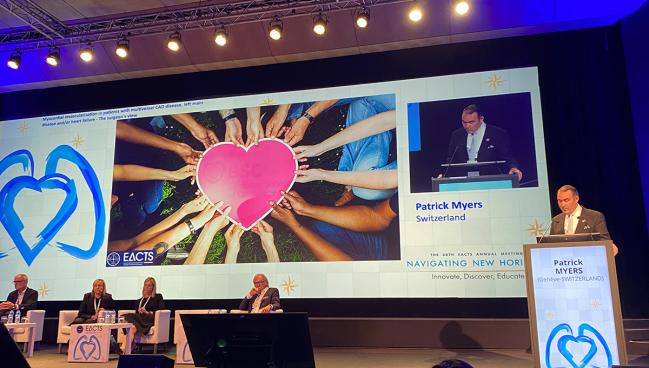At EACTS 2024, Surgeons and Cardiologists Move Past EXCEL Firestorm
The latest ESC CCS guidelines represent a turning point in old turf wars pitting CABG and PCI against each other in left main disease.

LISBON, Portugal—Five years ago, the chair of the EXCEL trial surgical committee stood on stage at the 2019 European Association for Cardio-Thoracic Surgery (EACTS) meeting and accused the trial’s leadership of manipulating the data—igniting a firestorm between surgeons and interventional cardiologists.
But this month at EACTS 2024, in that very same auditorium, representatives from both sides seemed ready to leave the past behind.
In a joint EACTS and European Society of Cardiology (ESC) session, Alaide Chieffo, MD (Vita Salute San Raffaele University, Milan, Italy), and Patrick Myers, MD (Lausanne University Hospitals, Switzerland), were slated to debate the best coronary revascularization strategies for patients with multivessel CAD, left main disease, and/or heart failure. Instead, more harmoniously, the two discussed the many permutations of appropriateness for PCI and CABG, often referencing the ESC’s latest iteration of guidelines for the treatment of chronic coronary syndromes (CCS) using a patient-centered approach.
The CCS guidelines themselves represent an olive branch of sorts between cardiologists and surgeons, who came together to write and sponsor them after EACTS formally withdrew its support from the 2018 left main document following the EXCEL controversy.
Chieffo, who serves as the president of the European Association of Percutaneous Cardiovascular Interventions (EAPCI) and was on the writing committee of the new guidelines, told TCTMD she’s happy with the current detente. “As always, it takes a while,” she said. “Being on the task force for the European Society of Cardiology CCS guidance was work—we did a lot of work.”
It took time to find harmony, Chieffo continued, “but at the end of the day, I think it’s evidence and people that make the difference.”
We've gone full circle. Patrick Myers
“We've gone full circle,” Myers, who serves as the secretary general of EACTS, told TCTMD. The latest guidelines have a “left main chapter that EACTS endorses, because we all feel that this represents the evidence best,” he said. “It's very positive to see that we've gone from surgeons unilaterally looking at the data and saying, ‘Wait a minute, this is not reasonable. We don't agree with this,’ to saying, ‘Okay, let's work on this together,’ and coming full swing to have joint guidelines that we endorse.”
Session co-moderator Volkmar Falk, MD (German Heart Center Berlin, Germany), the current EACTS president, acknowledged the controversy of the past but encouraged cooperation going forward. “The fact that we just endorsed the latest guidelines of the ESC as an organization shows that we are very close with our cardiology friends,” he told attendees of the session. “While we consider this a debate, I think we'll come to an agreement, and that's the whole point. We do this for our patients and for ourselves.”
Back to the Data
For her talk, Chieffo stressed the need for a heart team discussion in complex cases where the CCS guidelines give the same class of recommendation to surgery and PCI. She also emphasized the new focus on a “patient-centered” approach.
“We have to take care of the single, individual patient, taking into consideration not only the anatomy of their coronaries but also the comorbidity of the patients, as well as the hospital practice and protocol,” Chieffo said. “Because clearly we are talking about guidelines that are extended to many countries where the capability of each individual center is not the same.”
The left main section of the CCS guidelines was “very intensely discussed” by the task force, she said. In the end, though, there was mutual agreement that CABG receive a class I, level of evidence A recommendation for patients at low surgical risk regardless of anatomy, noted Chieffo. For those with low anatomic complexity, PCI received the same class I, level of evidence A recommendation given that it is less invasive and associated with similar mortality, she added. PCI "may also be an option" in more complex scenarios in patients at high surgical risk.
At the end of the day, I think it’s evidence and people that make the difference. Alaide Chieffo
In his presentation, Myers explained that, with time, he’s come to understand that everyone’s understanding of data is biased by personal experience, and that this bias played a role both for surgeons and cardiologists in the left main revascularization controversy.
“But if you look at the data, there's no RCT that's shown survival [for] PCI over medical therapy,” he said. “A lot of the trials are designed to show noninferiority to CABG, and that is a somewhat skewed comparison.”
Still, he noted that much of the surgical data are observational not randomized, leading to unresolved questions. “We are far behind. In interventional cardiology, you're more advanced. It's definitely something that we need to do,” he said.
Patient Centered vs Patient Preference
The concept of “patient centered” seemed to stoke some confusion during the discussion, with Chieffo having to redefine it at least twice, clarifying that the CCS guidelines do not specify that every single patient should be reviewed by the heart team.
“There are specific patients where you should have a heart team, otherwise it would be too complicated,” she said.
Defining exactly how the heart team works remains a “big problem,” Myers said. “That’s something hopefully we will be working on in the future. . . . In a way, we should make the decision of heart team reproducible in that if we give the same file to [a different] group of people, they should reach the same conclusion, which is not always the case.”
Nor do the guidelines place undue weight on patient preference, she clarified—something that is an oft-heard concern of surgeons who can empathize with the desire to undergo a less invasive procedure while also wanting to give their patients the best care.
“We want the patient in the center of the decision-making process, right?” Falk said. “But at the same time, how can we guarantee that we give the best information to the patient, and do it in a nonbiased way? And also convince patients that, yes, [surgery] may be more invasive, but it may be the best thing for them in the long run?”
Chieffo clarified that a patient-centered approach does not mean being guided solely by patient preferences.
“Patient centric is something that involves more features being taken into account,” she said. “It's not the same for all patients. It's not patient preference, but patient centered: moving from pathology itself to deep, deep emphasis on that specific patient.”
The fact that we just endorsed the latest guidelines of the ESC as an organization shows that we are very close with our cardiology friends. Volkmar Falk
Following the presentations, audience member Christoph Nienaber, MD, PhD (Royal Brompton Hospital, London, England), observed that patient inclusion in the decision-making process is “more and more important now.” If a patient has multiple treatment options and ultimately refused to get CABG, “what can you do?” he said. “In the end, we are a service provider, and we give you another option, be it medical management or multivessel PCI. The options are always there.”
Another audience member, Mustafa Cikirikcioglu, MD, PhD (University Hospitals of Geneva, Switzerland), called the heart team “the most important revolution” he’s seen in his surgical career but also voiced concern that patient-centered decision-making can in some cases be “abused.”
“If there is not a real heart team discussion for a patient, there is a potential risk that the patient may [prefer] the percutaneous revascularization, despite surgical revascularization [being] the most appropriate one,” Cikirikcioglu argued, adding that in his experience, he has also seen too much weight being placed on patient preference over best evidence.
Building Bridges
Looking forward, Myers noted, “the future is bright and just having cardiologists here at the meeting is proof of that. Like in our home institutions, we can work together very well.”
To TCTMD, he said the EACTS has been actively working to build bridges with other associations that represent the spectrum of the heart team by hosting joint sessions, attending other societies’ meetings, and encouraging open-mindedness. “Once we've gotten through the discussion about guidelines and turf wars and things like that, we realize that actually the mindset of an interventional cardiologist is much closer to the mindset of a surgeon,” he said.
Falk, too, called out the importance of attending a wide variety of conferences. “It's important to also go to the cardiology meetings,” he said. “Go to ESC, go to EuroPCR, be present at these meetings, and engage in the discussion there. It’s one thing to discuss this here at EACTS, where we’re all cardiac surgeons. It's easy. We have to also join our cardiology friends and go to their meetings, and maybe you do, but I think this is a task that we all have.”
“The only way to go is collaboration,” Chieffo said. “I don't think our field of cardiology and cardiovascular disease can be without collaboration, and collaboration is in the interest of the patient.”
Yael L. Maxwell is Senior Medical Journalist for TCTMD and Section Editor of TCTMD's Fellows Forum. She served as the inaugural…
Read Full BioSources
Chieffo A. Myocardial revascularization in CCS patients with multivessel CAD, left main disease and/or heart failure. Presented at: EACTS 2024. October 10, 2024. Lisbon, Portugal.
Myers PO. Myocardial revascularization: the surgeon’s view. Presented at: EACTS 2024. October 10, 2024. Lisbon, Portugal.
Disclosures
- Chieffo and Myers report no relevant conflicts of interest.





Comments